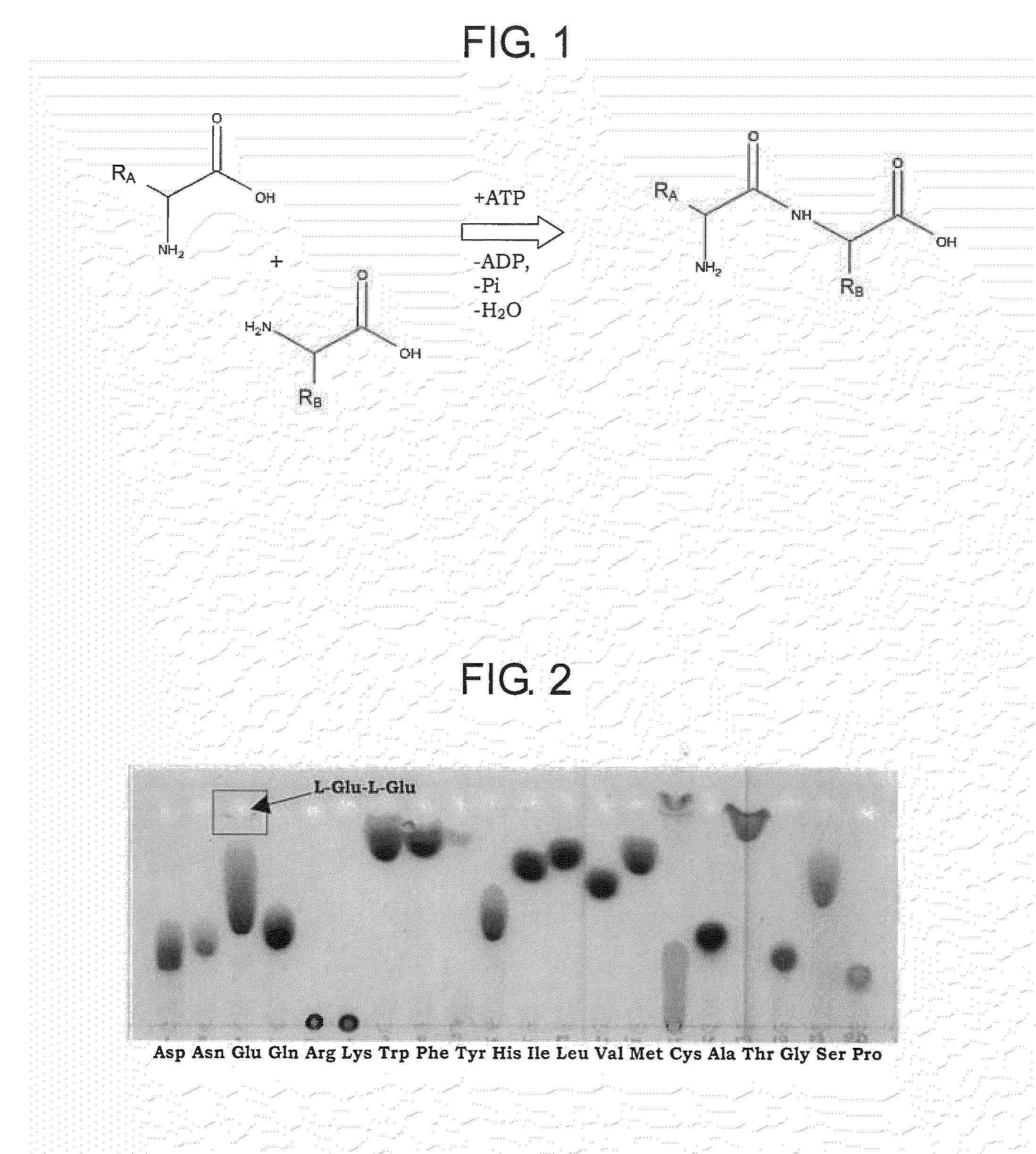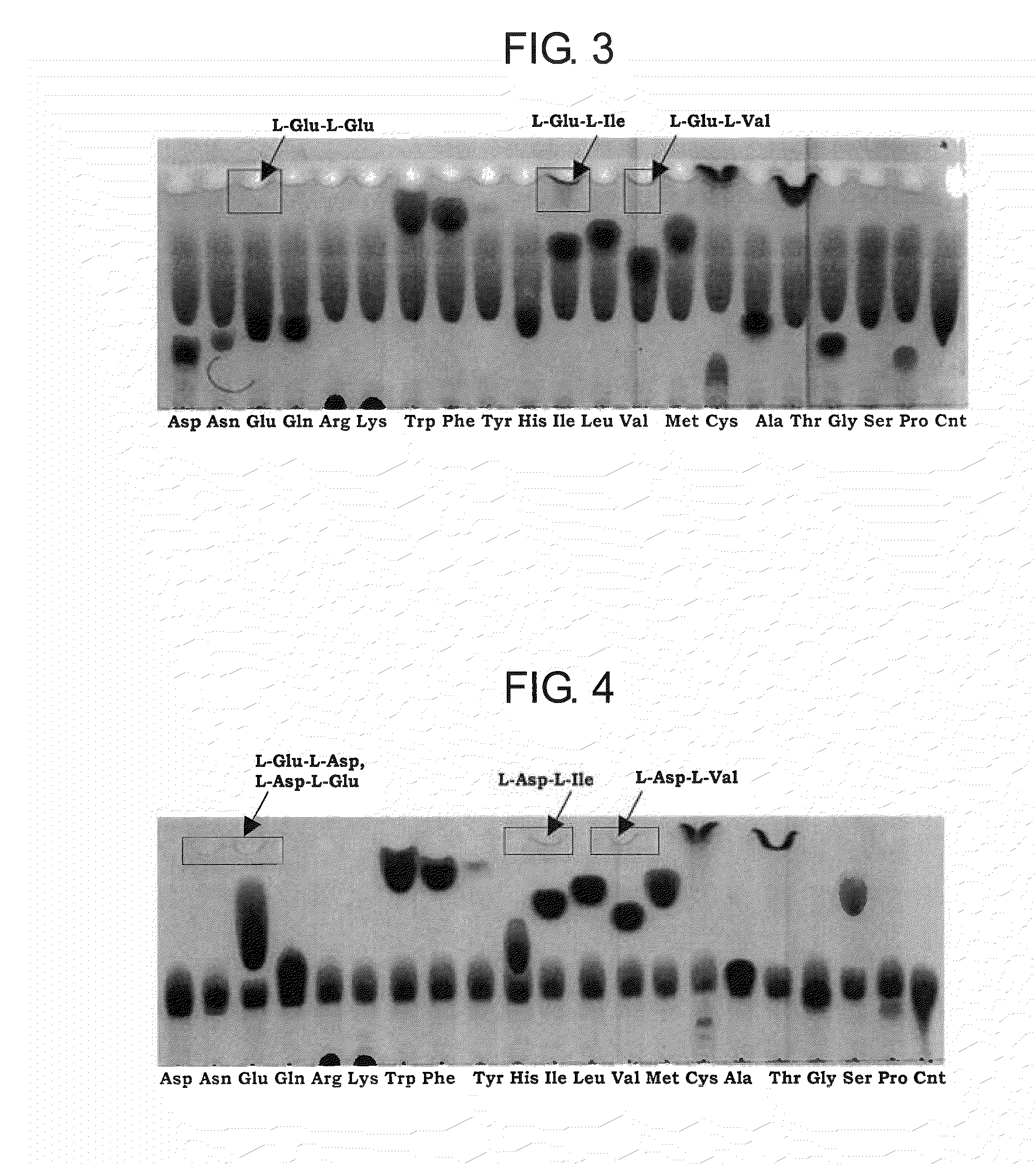DNA encoding dipeptide-synthesizing enzyme (variants), bacterium belonging to the genus escherichia, and methods for producing dipeptides using thereof
a dipeptide-synthesizing enzyme and dipeptide-producing technology, which is applied in the field of biotechnology industry, can solve the problems of cost, efficiency, and disadvantage of the process, and achieve the effect of avoiding the need to discard the concomitant chemicals, reducing the number of dna
- Summary
- Abstract
- Description
- Claims
- Application Information
AI Technical Summary
Benefits of technology
Problems solved by technology
Method used
Image
Examples
example 1
Cloning of BBR47—51900 from Brevibacillus brevis NBRC 100599 and Staur—4851 from Stigmatella aurantiaca DW4 / 3-1
[0200]The primary structure of the genes encoding the hypothetical proteins BBR47—51900 and Staur—4851 was optimized for expression in E. coli The genes encoding BBR47—51900 from Brevibacillus brevis NBRC 100599 and Staur—4851 from Stigmatella aurantiaca DW4 / 3-1 were synthesized by the SlonoGene™ gene synthesis service (http: / / www.sloning.com / ) and delivered as a set of pSlo.X plasmids harboring the synthesized XbaI-EcoRI fragment which included the target genes having optimized sequences. The XbaI-EcoRI fragments harboring genes with optimized sequences encoding the BBR47—51900 and Staur—4851 proteins are shown in SEQ ID NOs: 19 and 20, respectively.
[0201]To construct the pET-HT-BBR and pET-HT-STA plasmids, the corresponding XbaI-EcoRI fragments of the pSlo.X plasmids were excised by digestion with XbaI and EcoRI and then ligated with the pET15(b+) vector (Novagen, USA) di...
example 2
Expression and Purification of His6-Tagged BBR47—51900 and Staur—4851
[0202]Plasmids pET-HT-BBR and pET-HT-STA were introduced into BL21 (DE3) strain (Novagen, USA) by Ca2+-dependent transformation to construct the BL21 (DE3) [pET-HT-BBR] and BL21 (DE3) [pET-HT-STA] strains. The electrotransformation was done using “Bio-Rad” electroporator (USA) (No. 165-2098, version 2-89) according to the manufacturer's instructions. Cells of the BL21 (DE3) [pET-HT-BBR] and BL21 (DE3) [pET-HT-STA] strains were each grown in LB broth (also referred to as lysogenic broth as described in Sambrook, J. and Russell, D. W. (2001) Molecular Cloning: A Laboratory Manual (3rd ed.). Cold Spring Harbor Laboratory Press) at 37° C. up to OD540 ˜1 and 150 rpm. Isopropyl-β-D-thio-galactoside (IPTG) was added to a final concentration of 1 mM, and the cell culture was incubated for 2 hours at 37° C. and 150 rpm. Induced cells were harvested from 1 L of cultivation broth, re-suspended in 60-80 mL of HT-I-buffer (20 m...
example 3
Preliminary Analysis of Substrate Specificity of BBR47—51900 and Staur—4851
[0203]The substrate specificity of BBR47—51900 and Staur—4851 was studied in the reaction mixture containing the enzyme and canonical L-amino acids such as L-alanine, L-arginine, L-asparagine, L-aspartic acid, L-cysteine, glycine, L-glutamic acid, L-glutamine, L-histidine, L-isoleucine, L-leucine, L-lysine, L-methionine, L-phenylalanine, L-proline, L-serine, L-threonine, L-tryptophan, L-tyrosine, and L-valine, or salts thereof, of the same or two different kinds. The composition of the reaction mixture of total volume of 50 μL was as follows unless otherwise noted:
BBR47_51900 or Staur_48514μgTris-HCl, pH 8.050mMFirst L-amino acid10mMSecond L-amino acid10mMAdenosine 5′-triphosphate (ATP)10mMMgSO4×7H2O10mMH2Oto 50 μL
[0204]Reactions were carried out at 32° C. for 15 hours. 1-2 μL of reaction mixture was subjected to thin layer chromatography (TLC) analysis using as mobile phase the mixture of 2-propanol:acetone:...
PUM
| Property | Measurement | Unit |
|---|---|---|
| concentration | aaaaa | aaaaa |
| NMR | aaaaa | aaaaa |
| HPLC | aaaaa | aaaaa |
Abstract
Description
Claims
Application Information
 Login to View More
Login to View More - R&D
- Intellectual Property
- Life Sciences
- Materials
- Tech Scout
- Unparalleled Data Quality
- Higher Quality Content
- 60% Fewer Hallucinations
Browse by: Latest US Patents, China's latest patents, Technical Efficacy Thesaurus, Application Domain, Technology Topic, Popular Technical Reports.
© 2025 PatSnap. All rights reserved.Legal|Privacy policy|Modern Slavery Act Transparency Statement|Sitemap|About US| Contact US: help@patsnap.com



